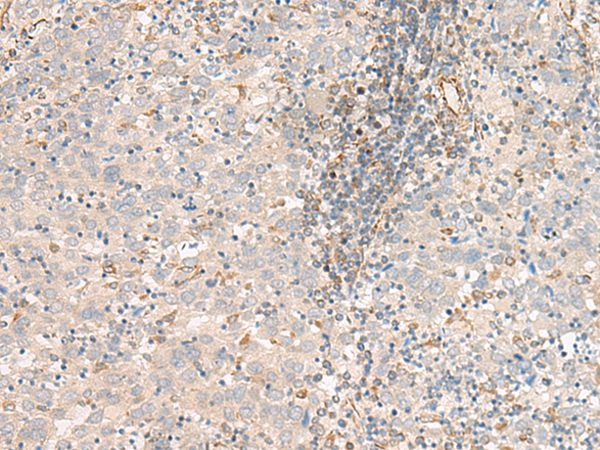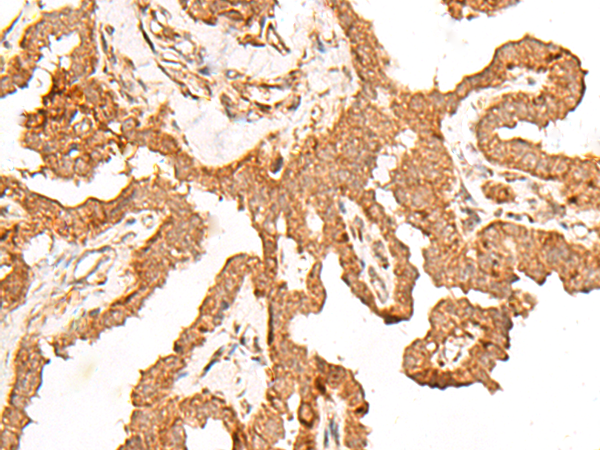

| WB | 咨询技术 | Human,Mouse,Rat |
| IF | 咨询技术 | Human,Mouse,Rat |
| IHC | 1/50-1/300 | Human,Mouse,Rat |
| ICC | 技术咨询 | Human,Mouse,Rat |
| FCM | 咨询技术 | Human,Mouse,Rat |
| Elisa | 1/5000-1/10000 | Human,Mouse,Rat |
| Aliases | TYK3; PPP1R74; p94-Fer |
| Host/Isotype | Rabbit IgG |
| Antibody Type | Primary antibody |
| Storage | Store at 4°C short term. Aliquot and store at -20°C long term. Avoid freeze/thaw cycles. |
| Species Reactivity | Human, Mouse, Rat |
| Immunogen | Synthetic peptide of human FER |
| Formulation | Purified antibody in PBS with 0.05% sodium azide and 50% glycerol. |
+ +
以下是3篇与FER抗体相关的文献概览,供参考:
---
1. **文献名称**:*FER kinase promotes breast cancer metastasis and drug resistance by regulating EGFR signaling*
**作者**:Li Y, et al.
**摘要**:本研究揭示FER激酶通过增强EGFR信号通路促进乳腺癌细胞侵袭和转移。实验表明,使用FER特异性抗体抑制其活性可降低肿瘤耐药性,为靶向治疗提供新方向。
---
2. **文献名称**:*Structural basis of FER-mediated PSGL-1 recognition in leukocyte trafficking*
**作者**:Wang X, et al.
**摘要**:该研究解析了FER激酶胞外结构域与PSGL-1蛋白结合的晶体结构,阐明FER抗体在阻断白细胞炎症迁移中的作用机制,为抗炎药物开发提供结构依据。
---
3. **文献名称**:*FER regulates mitochondrial ROS production and neuronal death in Parkinson’s disease models*
**作者**:Chen J, et al.
**摘要**:发现FER激酶在帕金森病模型中调控线粒体ROS生成,通过特异性抗体抑制FER可减轻多巴胺能神经元损伤,提示其在神经退行性疾病中的潜在治疗价值。
---
4. **文献名称**:*Antibody-based profiling of FER expression in colorectal cancer progression*
**作者**:Kim S, et al.
**摘要**:利用FER特异性抗体分析结直肠癌组织样本,发现FER高表达与肿瘤分期和预后不良相关,提示FER可作为癌症生物标志物及治疗靶点。
---
以上文献涵盖FER抗体在癌症、炎症、神经疾病中的机制与应用研究。如需具体文章,建议通过PubMed或期刊官网检索标题获取全文。
FER (Fps/Fes Related) antibodies target a member of the Fes/Fer non-receptor protein-tyrosine kinase family, which includes Fes and Fer. The FER gene encodes a cytoplasmic kinase implicated in diverse cellular signaling pathways. Structurally, FER contains an N-terminal F-BAR domain involved in membrane association and cytoskeletal regulation, a central SH2 domain mediating protein-protein interactions, and a C-terminal kinase domain responsible for catalytic activity.
FER regulates processes like cell adhesion, migration, proliferation, and differentiation. It interacts with receptor tyrosine kinases (e.g., CSF-1R, PDGFR, EGFR) and modulates downstream pathways such as PI3K-Akt and MAPK. In immune cells, FER influences inflammatory responses by regulating cytokine signaling and phagocytosis. Dysregulation of FER is linked to cancer progression, including leukemia, breast, and prostate cancers, where it promotes tumor survival, invasion, and metastasis.
Antibodies against FER are essential tools for studying its expression, localization, and function in physiological and pathological contexts. They enable detection via techniques like Western blot, immunohistochemistry, and immunoprecipitation. Research using FER antibodies has highlighted its role as a potential therapeutic target, with inhibitors under exploration for oncology applications. Understanding FER’s molecular mechanisms remains critical for unraveling its contributions to cellular homeostasis and disease.
×